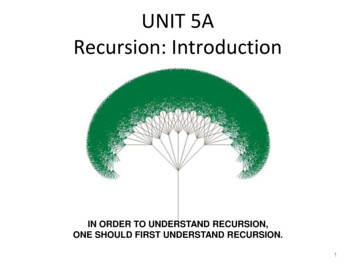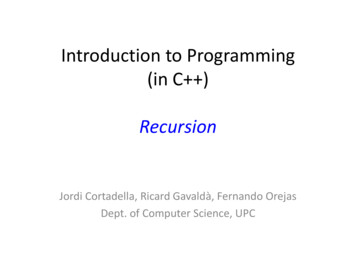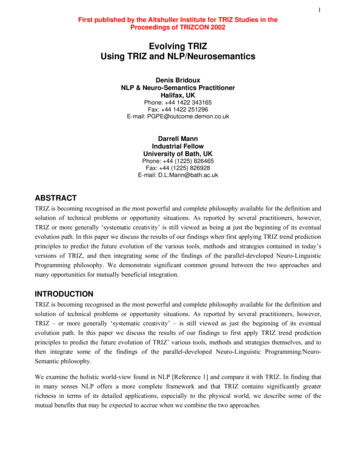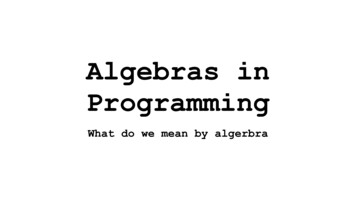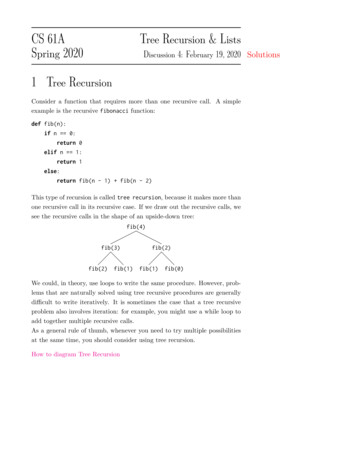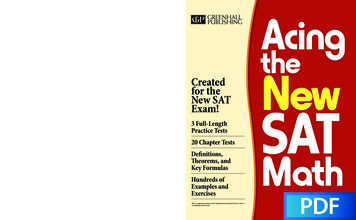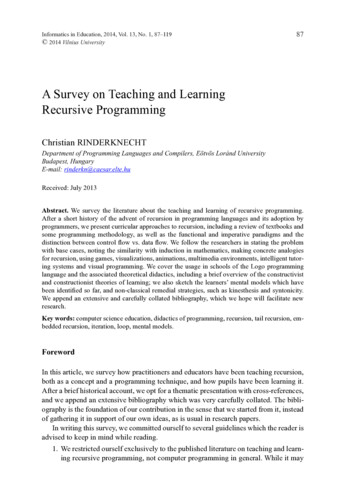
Transcription
The Recursive Book of Recursion (Sample Chapter) 2/28/22 by Al Sweigart1W H AT I S R E C U R S I O N?IVEURSREC OFTHE BOOK IONURSRECTHWIIEW TRVIPTECRINASNGAVDID JCOANHEONE TTHACPYTHEAEIVRSCU OF NRE OK SIOBO URCRECEWW TIE IPVR CRTE ASIN VGJAIN DDNOAC NEOTH THYPITHIVE ECOHRECURSYTHACETPRecursion has an intimidating reputation.It’s considered hard to understand, butat its core, it depends on only two things: f unction calls and stack data structures.Most new programmers trace through what a program does by following the execution. It’s an easy way to read code: you just put your fingeron the line of code at the top of the program and move down. Sometimesyour finger will loop back; other times, it will jump into a function and laterreturn. This makes it easy to visualize what a program does and in whatorder.But to understand recursion, you need to become familiar with a lessobvious data structure, called a stack, that controls the program’s flow ofexecution. Most programming beginners don’t know about stacks, becauseprogramming tutorials often don’t even mention them when discussingfunction calls. Furthermore, the call stack that automatically manages function calls doesn’t appear anywhere in the source code.
The Recursive Book of Recursion (Sample Chapter) 2/28/22 by Al SweigartIt’s hard to understand something when you can’t see it and don’t knowit exists! In this chapter, we’ll pull back the curtain to dispel the overblownnotion that recursion is hard, and you’ll be able to appreciate the eleganceunderneath.The Definition of RecursionBefore we discuss recursion, let’s get the clichéd recursion jokes out of theway, starting with this: “To understand recursion, you must first understandrecursion.”During the months I’ve spent writing this book, I can assure you thatthis joke gets funnier the more you hear it.Another joke is that if you search Google for recursion, the results pageasks if you mean recursion. Following the link, as shown in Figure 1-1, takesyou to . . . the search results for recursion.Figure 1-1: The Google search results for recursion link to the Google search resultsfor recursion.Figure 1-2 shows a recursion joke from the webcomic xkcd.Figure 1-2: I’m So Meta, EvenThis Acronym (I.S. M.E.T.A.)Most jokes about the 2010 science-fiction action movie Inception arerecursion jokes. The film features characters having dreams within dreamswithin dreams.And finally, what computer scientist could forget that monster fromGreek mythology, the recursive centaur? As you can see in Figure 1-3, it ishalf horse, half recursive centaur.2Chapter 1
The Recursive Book of Recursion (Sample Chapter) 2/28/22 by Al SweigartFigure 1-3: The recursive centaur. Image by Joseph Parker.Based on these jokes, you might conclude that recursion is a sort of meta,self-referencing, dream-within-a-dream, infinite mirror-into-mirror sort ofthing. Let’s establish a concrete definition: a recursive thing is somethingwhose definition includes itself. That is, it has a self-referential definition.The Sierpiński triangle in Figure 1-4 is defined as an equilateral triangle with an upside-down triangle in the middle that forms three newequilateral triangles, each of which contains a Sierpiński triangle. The definition of Sierpiński triangles includes Sierpiński triangles.Figure 1-4: Sierpiński triangles are fractals (recursive shapes) that include Sierpińskitriangles.In a programming context, a recursive function is a function that callsitself. Before we explore recursive functions, let’s take a step back and understand how regular functions work. Programmers tend to take function callsfor granted, but even experienced programmers will find it worthwhile toreview functions in the next section.What Are Functions?Functions can be described as mini-programs inside your program. They’re afeature of nearly every programming language. If you need to run identicalWhat is Recursion?3
The Recursive Book of Recursion (Sample Chapter) 2/28/22 by Al Sweigartinstructions at three different places in a program, instead of copying andpasting the source code three times, you can write the code in a functiononce and call the function three times. The beneficial result is a shorter andmore readable program. The program is also easier to change: If you needto fix a bug or add features, you need to change your program in only oneplace instead of three.All programming languages implement four features in their functions:1. Functions have code that is run when the function is called.2. Arguments (that is, values) are passed to the function when it’s called.This is the input to the function, and functions can have zero or morearguments.3. Functions return a return value. This is the output of the function,though some programming languages allow functions to not returnanything or return null values like undefined or None.4. The program remembers which line of code called the function andreturns to it when the function finishes its execution.Different programming languages might have additional features, ordifferent options for how to call functions, but they all have these four general elements. You can visually see the first three of these elements becauseyou write them in the source code, but how does a program keep track ofwhere the execution should return to when the function returns?To get a better sense of the problem, create a functionCalls.py programthat has three functions: a(), which calls b(), which calls c():Pythondef a():print('a() was called.')1 b()print('a() is returning.')def b():print('b() was called.')2 c()print('b() is returning.')def c():print('c() was called.')print('c() is returning.')a()This code is equivalent to the following functionCalls.html program:JavaScript4Chapter 1 script type "text/javascript" function a() {document.write("a() was called. br / ");1 b();document.write("a() is returning. br / ");}
The Recursive Book of Recursion (Sample Chapter) 2/28/22 by Al Sweigartfunction b() {document.write("b() was called. br / ");2 c();document.write("b() is returning. br / ");}function c() {document.write("c() was called. br / ");document.write("c() is returning. br / ");}a(); /script When you run this code, the output looks like this:a()b()c()c()b()a()was called.was called.was called.is returning.is returning.is returning.The output shows the start of functions a(), b(), and c(). Then, when thefunctions return, the output appears in reverse order: c(), b(), and then a().Notice the pattern to the text output: each time a function returns, it remembers which line of code originally called it. When the c() function call ends,the program returns to the b() function and displays b() is returning. Thenthe b() function call ends, and the program returns to the a() function anddisplays a() is returning. Finally, the program returns to the original a()function call at the end of the program. In other words, function calls don’tsend the execution of the program on a one-way trip.But how does the program remember if it was a() 1 or b() 2 that calledc()? This detail is handled by the program implicitly with a call stack. Tounderstand how call stacks remember where the execution returns at theend of a function call, we need to first understand what a stack is.What Are Stacks?Earlier I mentioned the clichéd wisecrack, “To understand recursion, youmust first understand recursion.” But this is actually wrong: to really understand recursion, you must first understand stacks.A stack is one of the simplest data structures in computer science. Itstores multiple values like a list does—but unlike lists, it limits you to adding to or removing values from the “top” of the stack only. For lists, the“top” is the last item, at the right end of the list. Adding values is calledpushing values onto the stack, while removing values is called popping values off the stack.Imagine that you’re engaged in a meandering conversation with someone. You’re talking about your friend Alice, which then reminds you of aWhat is Recursion?5
The Recursive Book of Recursion (Sample Chapter) 2/28/22 by Al Sweigartstory about your coworker Bob, but for that story to make sense, you firsthave to explain something about your cousin Carol. You finish your storyabout Carol and go back to talking about Bob, and when you finish yourstory about Bob, you go back to talking about Alice. Then you are remindedabout your brother David, so you tell a story about him. Eventually, you getaround to finishing your original story about Alice.Your conversation follows a stack-like structure, as in Figure 1-5. Theconversation is stack-like because the current topic is always at the top ofthe AliceAliceFigure 1-5: Your meandering conversation stackIn our conversation stack, the new topics are added to the top of thestack and taken off as they are completed. The previous topics are “remembered” underneath the current topic in the stack.We can use Python lists as stacks if, to amend the list’s contents, welimit ourselves to the append() and pop() methods to perform pushing andpopping. JavaScript arrays can also be used as stacks through their push()and pop() methods.NOTEPython uses the terms list and item, while JavaScript uses the terms array and element, but they are respectively identical for our purposes. In this book, I use the termslist and item for both languages.For example, consider this cardStack.py program, which pushes andpops string values of playing cards to the end of a list named cardStack:PythoncardStack 1 []2 cardStack.append('5 of nd('3 of 'ace of hearts')print(','.join(cardStack))3 cardStack.pop()print(','.join(cardStack))The following cardStack.html program contains the equivalent code inJavaScript:JavaScript6Chapter 1 script type "text/javascript" let cardStack 1 [];2 cardStack.push("5 of diamonds");document.write(cardStack " br / ");cardStack.push("3 of clubs");document.write(cardStack " br / ");
The Recursive Book of Recursion (Sample Chapter) 2/28/22 by Al SweigartcardStack.push("ace of hearts");document.write(cardStack " br / ");3 cardStack.pop()document.write(cardStack " br / "); /script When you run this code, the output looks like this:5555ofofofofdiamondsdiamonds,3 of clubsdiamonds,3 of clubs,ace of heartsdiamonds,3 of clubsThe stack starts off as empty 1. Three strings representing cards arepushed onto the stack 2. Then the stack is popped 3, which removes theace of hearts and leaves the three of clubs at the top of the stack again. Thestate of the cardStack stack is tracked in Figure 1-6, going from left to right.EmptyFigure 1-6: The stack starts empty. Cards are then pushed onto and popped off the stack.You can see only the topmost card in the card stack, or, in our program’s stacks, the topmost value. In the simplest stack implementations,you can’t see how many cards (or values) are in the stack. You can see onlywhether the stack is empty or not.Stacks are a LIFO data structure, which stands for last in, first out, sincethe last value pushed onto the stack is the first value popped out of it. Thisbehavior is similar to your web browser’s Back button. Your browser tab’shistory functions like a stack that contains all the pages you’ve visited in theorder that you visited them. The browser is always displaying the web pageat the “top” of the history’s “stack.” Clicking a link pushes a new web pageonto the history stack, while clicking the Back button pops the top webpage off and reveals the one “underneath.”What Is the Call Stack?Programs use stacks too. The program’s call stack, also simply called thestack, is a stack of frame objects. Frame objects, also simply called frames, contain information about a single function call, including which line of codecalled the function, so the execution can move back there when the function returns.What is Recursion?7
The Recursive Book of Recursion (Sample Chapter) 2/28/22 by Al SweigartFrame objects are created and pushed onto the stack when a functionis called. When the function returns, that frame object is popped off thestack. If we call a function that calls a function that calls a function, the callstack will have three frame objects on the stack. When all of these functionsreturn, the call stack will have zero frame objects on the stack.Programmers don’t have to write code dealing with frame objects, sincethe programming language handles them automatically. Different programming languages have different ways of implementing frame objects,but in general they contain the following: The return address, or the spot in the program where the executionshould move when the function returnsThe arguments passed to the function callA set of local variables created during the function callFor example, take a look at the following localVariables.py program,which has three functions, just as our previous functionCalls.py and functionCalls.html programs did:Pythondef123a():spam 'Ant'print('spam is ' spam)b()print('spam is ' spam)def b():4 spam 'Bobcat'print('spam is ' spam)5 c()print('spam is ' spam)def c():6 spam 'Coyote'print('spam is ' spam)7 a()This localVariables.html is the equivalent JavaScript program:JavaScript script type "text/javascript" function a() {1 let spam "Ant";2 document.write("spam is " spam " br / ");3 b();document.write("spam is " spam " br / ");}function b() {4 let spam "Bobcat";document.write("spam is " spam " br / ");5 c();document.write("spam is " spam " br / ");8Chapter 1
The Recursive Book of Recursion (Sample Chapter) 2/28/22 by Al Sweigart}function c() {6 let spam "Coyote";document.write("spam is " spam " br / ");}7 a(); /script When you run this code, the output looks like BobcatAntWhen the program calls function a() 7, a frame object is created andplaced on the top of the call stack. This frame stores any arguments passedto a() (in this case, there are none), along with the local variable spam 1and the place where the execution should go when the a() function returns.When a() is called, it displays the contents of its local spam variable,which is Ant 2. When the code in a() calls function b() 3, a new frameobject is created and placed on the call stack above the frame object fora(). The b() function has its own local spam variable 4, and calls c() 5. Anew frame object for the c() call is created and placed on the call stack,and it contains c()’s local spam variable 6. As these functions return, theframe objects pop off the call stack. The program execution knows whereto return to, because that return information is stored in the frame object.When the execution has returned from all function calls, the call stack isempty.Figure 1-7 shows the state of the call stack as each function is calledand returns. Notice that all the local variables have the same name: spam.I did this to highlight the fact that local variables are always separate variables with distinct values, even if they have the same name as other localvariables.a()Emptyb()spam 'Bobcat′spam 'Ant′b()c()spam 'Bobcat′spam 'Coyote′a()spam 'Ant′EmptyFigure 1-7: The state of the call stack as the localVariables program runsWhat is Recursion?9
The Recursive Book of Recursion (Sample Chapter) 2/28/22 by Al SweigartAs you can see, programming languages can have separate local variables with the same name (spam) because they are kept in separate frameobjects. When a local variable is used in the source code, the variable withthat name in the topmost frame object is used.Every running program has a call stack, and multithreaded programshave one call stack for each thread. But when you look at the source codefor a program, you can’t see the call stack in the code. The call stack isn’tstored in a variable as other data structures are; it’s automatically handledin the background.The fact that the call stack doesn’t exist in source code is the main reason recursion is so confusing to beginners: recursion relies on somethingthe programmer can’t even see! Revealing how stack data structures andthe call stack work removes much of mystery behind recursion. Functionsand stacks are both simple concepts, and we can use them together tounderstand how recursion works.What Are Recursive Functions and Stack Overflows?A recursive function is a function that calls itself. This shortest.py program isthe shortest possible example of a recursive function:Pythondef shortest():shortest()shortest()The preceding program is equivalent to this shortest.html program:JavaScript script type "text/javascript" function shortest() {shortest();}shortest(); /script The shortest() function does nothing but call the shortest() function.When this happens, it calls the shortest() function again, and that will callshortest(), and so on seemingly forever. It is similar to the mythological ideathat the crust of the Earth rests on the back of a giant space turtle, whichrests on the back of another turtle. Beneath that turtle: another turtle. Andso on, forever.But this “turtles all the way down” theory doesn’t do a good job ofexplaining cosmology, nor recursive functions. Since the call stack uses thecomputer’s finite memory, this program cannot continue forever, the wayan infinite loop does. The only thing this program does is crash and displayan error message.NOTE10Chapter 1To view the JavaScript error, you must open the browser developer tools. On mostbrowsers, this is done by pressing F12 and then selecting the Console tab.
The Recursive Book of Recursion (Sample Chapter) 2/28/22 by Al SweigartThe Python output of shortest.py looks like this:Traceback (most recent call last):File "shortest.py", line 4, in module shortest()File "shortest.py", line 2, in shortestshortest()File "shortest.py", line 2, in shortestshortest()File "shortest.py", line 2, in shortestshortest()[Previous line repeated 996 more times]RecursionError: maximum recursion depth exceededThe JavaScript output of shortest.html looks like this in the GoogleChrome web browser (other browsers will have similar error messages):Uncaught RangeError: Maximum call stack size exceededat shortest (shortest.html:2)at shortest (shortest.html:3)at shortest (shortest.html:3)at shortest (shortest.html:3)at shortest (shortest.html:3)at shortest (shortest.html:3)at shortest (shortest.html:3)at shortest (shortest.html:3)at shortest (shortest.html:3)at shortest (shortest.html:3)This kind of bug is called a stack overflow. (This is where the popular website https://stackoverflow.com gets its name.) The constant function calls with noreturns grows the call stack until it uses up all of the computer’s memory allocated for the call stack. To prevent this, the Python and JavaScript interpreters crash the program after a certain limit of function calls that don’t return.This limit is called the maximum recursion depth or maximum call stack size.For Python, this is set to 1,000 function calls. For JavaScript, the maximum callstack size depends on the browser running the code but is generally at least1,000 as well. Think of a stack overflow as happening when the call stack gets“too high” (that is, consumes too much computer memory), as in Figure 1-8.b()c()s pamspam'Cot′ ca yote′b'Bo!STACK TOO HIGHFigure 1-8: A stack overflow happens whenthe call stack becomes too high, with too manyframe objects taking up the computer’s memory.What is Recursion?11
The Recursive Book of Recursion (Sample Chapter) 2/28/22 by Al SweigartStack overflows don’t damage the computer. The computer just detectsthat the limit of function calls without returns has been reached and terminates the program. At worse, you’ll lose any unsaved work the program had.Stack overflows can be prevented by having something called a base case,which is explained next.Base Cases and Recursive CasesThe stack overflow example has a shortest() function that calls shortest()but never returns. To avoid a crash, there needs to be a case, or set of circumstances, where the function stops calling itself and instead just returns.This is called a base case. By contrast, a case where the function recursivelycalls itself is called a recursive case.All recursive functions require at least one base case and at least onerecursive case. If there is no base case, the function never stops makingrecursive calls and eventually causes a stack overflow. If there is no recursivecase, the function never calls itself and is an ordinary function, not a recursive one. When you start writing your own recursive functions, a good starting step is to figure out what the base case and recursive case should be.Take a look at this shortestWithBaseCase.py program, which defines theshortest recursive function that won’t crash from a stack overflow:Pythondef rtestWithBaseCase(%s) called.' % makeRecursiveCall)if not makeRecursiveCall:# BASE CASEprint('Returning from base case.')1 returnelse:# RECURSIVE CASE2 shortestWithBaseCase(False)print('Returning from recursive case.')returnprint('Calling shortestWithBaseCase(False):')3 shortestWithBaseCase(False)print()print('Calling shortestWithBaseCase(True):')4 shortestWithBaseCase(True)This code is equivalent to the following er 1 script type "text/javascript" function shortestWithBaseCase(makeRecursiveCall) {document.write("shortestWithBaseCase(" makeRecursiveCall ") called. br / ");if (makeRecursiveCall false) {// BASE CASEdocument.write("Returning from base case. br / ");1 return;
The Recursive Book of Recursion (Sample Chapter) 2/28/22 by Al Sweigart} else {// RECURSIVE CASE2 ing from recursive case. br / ");return;}}document.write("Calling shortestWithBaseCase(false): br / ");3 shortestWithBaseCase(false);document.write(" br / ");document.write("Calling shortestWithBaseCase(true): br / ");4 shortestWithBaseCase(true); /script When you run this code, the output looks like this:Calling alse) called.Returning from base case.Calling ue) called.shortestWithBaseCase(False) called.Returning from base case.Returning from recursive case.This function doesn’t do anything useful except provide a short example of recursion (and it could be made shorter by removing the text output,but the text is useful for our explanation). When shortestWithBaseCase(False)is called 3, the base case is executed and the function merely returns 1.However, when shortestWithBaseCase(True) is called 4, the recursive case isexecuted and shortestWithBaseCase(False) is called 2.It’s important to note that when shortestWithBaseCase(False) is recursivelycalled from 2 and then returns, the execution doesn’t immediately moveback to the original function call at 4. The rest of the code in the recursivecase after the recursive call still runs, which is why Returning from recursivecase. appears in the output. Returning from the base case doesn’t immediately return from all the recursive calls that happened before it. This will beimportant to keep in mind in the countDownAndUp() example in the next section.Code Before and After the Recursive CallThe code in a recursive case can be split into two parts: the code before therecursive call and the code after the recursive call. (If there are two recursive calls in the recursive case, such as with the Fibonacci sequence examplein Chapter 2, there will be a before, a between, and an after. But let’s keep itsimple for now.)The important thing to know is that reaching the base case doesn’t necessarily mean reaching the end of the recursive algorithm. It only meansthe base case won’t continue to make recursive calls.What is Recursion?13
The Recursive Book of Recursion (Sample Chapter) 2/28/22 by Al SweigartFor example, consider this countDownAndUp.py program whose recursive function counts from any number down to zero, and then back up tothe number:Pythondef countDownAndUp(number):1 print(number)if number 0:# BASE CASE2 print('Reached the base case.')returnelse:# RECURSIVE CASE3 countDownAndUp(number - 1)4 print(number, 'returning')return5 countDownAndUp(3)Here is the equivalent countDownAndUp.html program:JavaScript script type "text/javascript" function countDownAndUp(number) {1 document.write(number " br / ");if (number 0) {// BASE CASE2 document.write("Reached the base case. br / ");return;} else {// RECURSIVE CASE3 countDownAndUp(number - 1);4 document.write(number " returning br / ");return;}}5 countDownAndUp(3); /script When you run this code, the output looks like this:3210Reached the base case.1 returning2 returning3 returningRemember that every time a function is called, a new frame is created and pushed onto the call stack. This frame is where all the local variables and parameters (such as number) are stored. So, there is a separate14Chapter 1
The Recursive Book of Recursion (Sample Chapter) 2/28/22 by Al Sweigartnumber variable for each frame on the call stack. This is another often con-fusing point about recursion: even though, from the source code, it lookslike there is only one number variable, remember that because it is a localvariable, there is actually a different number variable for each function call.When countDownAndUp(3) is called 5, a frame is created, and that frame’slocal number variable is set to 3. The function prints the number variable to thescreen 1. As long as number isn’t 0, countDownAndUp() is recursively called withnumber - 1 2. When it calls countDownAndUp(2) 3, a new frame is pushed ontothe stack, and that frame’s local number variable is set to 2. Again, the recursive case is reached and calls countDownAndUp(1) 3, which again reaches therecursive case and calls countDownAndUp(0).This pattern of making consecutive recursive function calls and thenreturning from the recursive function calls is what causes the countdownof numbers to appear. Once countDownAndUp(0) is called, the base case isreached 2, and no more recursive calls are made. However, this isn’t theend of our program! When the base case is reached, the local number variable is 0. But when that base case returns, and the frame is popped offthe call stack, the frame under it has its own local number variable, with thesame 1 value it’s always had. As the execution returns back to the previousframes in the call stack, the code after the recursive call is executed 4.This is what causes the count up of numbers to appear. Figure 1-9 showsthe state of the call stack as countDownAndUp() is recursively called and ountDownAndUp()countDownAndUp()number 3number 2number 1number umber 1number 2number 3EmptyFigure 1-9: The call stack keeping track of the values in the number local variable for each function callWhat is Recursion?15
The Recursive Book of Recursion (Sample Chapter) 2/28/22 by Al SweigartThe fact that the code doesn’t stop immediately when the base case isreached will be important to keep in mind for the factorial calculation inthe next chapter. Remember, any code after the recursive case will still haveto run.At this point, you might be thinking that the recursive countDownAndUp()function is overengineered and difficult to follow. Why not, instead, usean iterative solution to print numbers? An iterative approach, which usesloops to repeat a task until it’s done, is usually thought of as the opposite ofrecursion.Whenever you find yourself asking, “Wouldn’t using a loop be easier?”the answer is almost certainly “Yes,” and you should avoid the recursive solution. Recursion can be tricky for both beginner and experienced programmers, and recursive code isn’t automatically “better” or “more elegant” thaniterative code. Readable, easy-to-understand code is more important thanany supposed elegance that recursion provides. However, on some occasions an algorithm cleanly maps to a recursive approach. Algorithms thatinvolve tree-like data structures and require backtracking are especiallysuited for recursion. These ideas are further explored in Chapter 2.SummaryRecursion often confuses new programmers, but it is built on the simpleidea that a function can call itself. Every time a function call is made, anew frame object with information related to the call (such as local variables and a return address for the execution to move to when the functionreturns) is added to the call stack. The call stack, being a stack data structure, can be altered only by having data added to or removed from its “top.”This is called pushing to and popping from the stack, respectively.The call stack is handled by the program implicitly, so there is no callstack variable. Calling a function pushes a frame object to the call stack,and returning from a function pops a frame object from the call stack.Recursive functions have recursive cases, those in which a recursive callis made, and base cases, those where the function simply returns. If thereis no base case or a bug prevents a base case from being run, the executioncauses a stack overflow that crashes the program.Recursion is a useful technique, but recursion doesn’t automaticallymake code “better” or more “elegant.” This idea is explored more in thenext chapter.Further ReadingYou can find other introductions to recursion in my 2018 North Bay Pythonconference talk, “Recursion for Beginners: A Beginner’s Guide to Recursion”at https://youtu.be/AfBqVVKg4GE. The YouTube channel Computerphile alsointroduces recursion in its video “What on Earth is Recursion?” at https://youtu.be/Mv9NEXX1VHc. Finally, V. Anton Spraul talks
function calls. Furthermore, the call stack that automatically manages func-tion calls doesn't appear anywhere in the source code. C U I E N F AE CO DI N TR E W I TH PT H A D A V S CP T TH ER CU R I E B O K F I N AC E TH OD IN G I T RV W PY O A J SC RP TH ER EC U SIV E BO K F S N ACE TH ODIN GT RV W PY OA JS RP The Recursive Book of Recursion .
